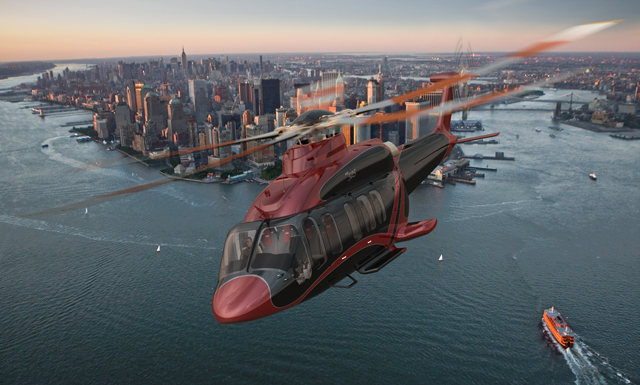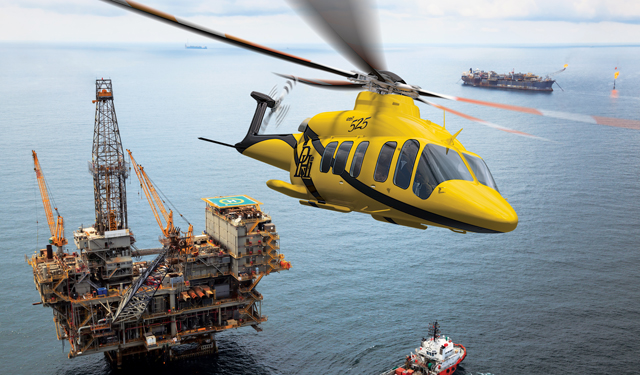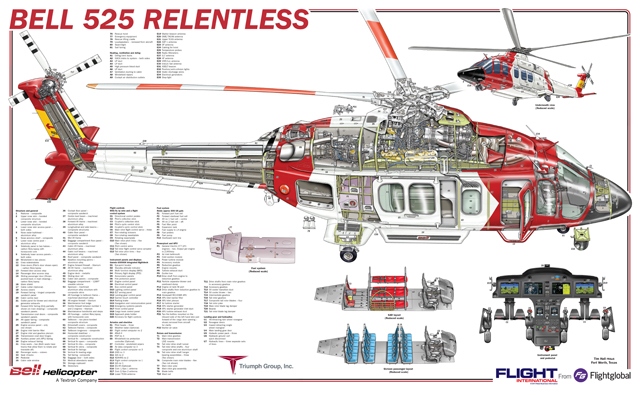If everything goes to plan and Bell Helicopter delivers its first 525 Relentless in 2016 to an as-yet unannounced customer, it will mark the end of the first chapter in the battle for market supremacy in the emerging segment for super-medium rotorcraft. Rivals AgustaWestland and Airbus Helicopters have already attained certification of their offerings in the weight class with the AW189 and EC175, respectively, so to some extent Bell is playing catch-up. Of course the company argues that the 525 will be worth waiting for – offering a higher maximum take-off weight (MTOW), better performance and reliability and, with a cockpit kitted out with the latest avionics and fly-by-wire controls, massively enhanced safety.
Of course, at this point in the development – with first flight still several months away – those performance characteristics are still at the theoretical stage, but Bell remains confident. It has already raised the maximum speed and range on one previous occasion and still remains coy on the MTOW figure, merely saying it will be “north of 19,300lb” – or 8.75t – suggesting a further bump at certification.
But to fully appreciate what Bell is trying to achieve, it is worth considering the drivers behind the evolution of the new segment. All three rotorcraft manufacturers are pitching their super-mediums primarily at operators working in the offshore oil and gas transportation industry, with search and rescue the second target market. Growth in oil and gas has been characterised by the movement of exploration facilities further offshore, requiring more capable rotorcraft to service them. That has given a boost to sales of heavy rotorcraft – essentially the EC225 and Sikorsky S-92 – but has also led to a requirement for something larger and more capable than a typical intermediate helicopter such as the 12-passenger, 6.8t AW139.

The 525 will be the first commercial helicopter to use the fly-by-wire controls
Bell Helicopter
That was the message the industry delivered to Bell when it embarked upon the initial studies for the programme in 2009. Its customer advisory panel (CAP) featured operators representing all major segments, says Bell senior vice-president of commercial programmes Matt Hasik. And although the airframer knew from the outset it would be “a medium-twin or medium-plus-type aircraft” regular contact with the CAP over the early months meant it was able to “finalise and crystallise the key value proposition and characteristics of the aircraft”. Hasik goes so far as to suggest that customers “have their fingerprints on the design of this aircraft”.
“One of things that we heard from a number of our oil and gas customers was the landscape of the oil and gas market was changing and potentially changing quite dramatically over the next 10 years,” he says.
“We wanted to ensure that we were designing and developing and flying an aircraft with superior productivity and economics. That’s where the size and capability of the 525 as a super-medium really fits well for us.”
At the time of the 525’s launch at the 2012 Heli-Expo show, AgustaWestland and what was then Eurocopter had already shown their hands with their super-medium helicopters, so Bell had reasonable visibility on where to place the Relentless.
During the design process, a number of factors were addressed, including performance, reliability, in-cabin comfort, safety and ease and cost of maintenance. “Across every single one of these dimensions, it will be a best-in-class machine,” says Hasik.
In the offshore market, safety has not been far from the headlines recently, with a focus in particular on the North Sea. Hasik points out that of the 11 design recommendations contained in the UK Civil Aviation Authority’s CAP 1145 report issued earlier this year, “the 525 is already compliant with 10 of them”. (For the record, the only one that it – and every other helicopter – cannot meet is the requirement for floatation devices at the top of the fuselage). Stability is ensured through the design of its floatation system and a low centre of gravity, says Hasik. Bell has tested a scale model of the 525 at sea state 6 for standard wave forms and sea state 5 for the uneven wave form (the maximum sea state currently available on the test rig). In both cases it passed without problem, he says. Passengers seated in the four rows of four seats all have easy access to large doors on either side of the fuselage, enabling easy exit. “No passenger is more than one seat away from the outside of this helicopter,” says Hasik. Elsewhere, the cockpit combines the all-new Garmin G5000H avionics suite and touchscreen displays with Bell’s developed-in-house fly-by-wire controls. It will be the first, and for some time the only, commercial helicopter to employ FBW technology, with other manufacturers shying away from the complexity inherent in its development. However, Bell feels that with its several decades of experience behind it – notably on the Bell Boeing V-22 Osprey and AW609 tiltrotors – it can afford to take a risk, albeit a calculated one, on the 525.
“When we stepped back and listened to our customers about their requirements for productivity, safety and reliability, and the kind of things pilots have to do in harsh operating environments, whether landing on a helipad at night in bad weather or performing a SAR mission deep offshore, the capabilities fly-by-wire provides is game-changing in terms of the commercial helicopter today,” says Hasik.
He describes the sidestick controls as “simple and intuitive” and a “natural evolution” of the systems on the AW609 and V-22. “It’s like having something better than a four-axis autopilot on all the time.”
A pilot can initiate a turn and even retrim the aircraft on the way into it and the helicopter will “maintain the attitude, heading, altitude and speed even if you are nowhere near the controls”. It will prove particularly beneficial in high-workload situations where task saturation becomes an issue, Hasik says, adding that with the FBW system, “you can very easily put the aircraft into a very safe operating condition and put eyes out of the window with less worry than you might normally have”. Tactile cues, like those found on modern fixed-wing transport aircraft, have also been added to the controls, allowing the pilot to receive simple feedback about what the helicopter is doing.
Another notable safety feature is triple redundancy on all the hydraulic actuators moving the critical rotor components. “Even in the eventuality of a twin failure the pilot retains sufficient authority to fly the aircraft safely,” says Hasik.
The cockpit features an unusual layout in that the pilots have no doors. Instead, their seats release backwards and pivot along what Bell calls its “J-Track” – as the name suggests, a J-shaped seat track – to allow them to exit the aircraft through the main cabin doors. This allows the creation of a “much more unobstructed field of view” in the front of the aircraft. The absence of cockpit doors and associated structures has removed weight, as well as what Hasik calls a “maintenance headache”.
Power on the 525 comes from a pair of 2,000shp (1,500kW) General Electric CT7-2F1s, a variant of the engines installed on the AW189. The GE powerplants were selected, says Hasik, for two reasons. First, a long history of service with the US military aboard Sikorsky UH-60 Black Hawks has shown the engine to be mature, easy to maintain and reliable, even in difficult operating conditions. “It makes it extremely suitable for this application for a commercial segment where harsh environments are the norm,” says Hasik. The other reason, he adds, is customer demand: “We had some very specific input from a number of operators” which suggested there was a “strong desire” for the incorporation of GE engines onto the Relentless.

Bell has pitched the Relentless squarely at the offshore transportation industry
Bell Helicopter
Those turboshafts drive a fully articulated, five-blade main rotor with a 55ft (16.7m) diameter and a four-blade tail rotor – both fabricated by Bell from carbonfibre – via a total of seven gearboxes. These are designed to work as efficiently as possible in the event of a loss of lubrication, and Hasik says the company is confident that the 525 will “not only meet but exceed” the 30min main gearbox dry-run capability required for certification. Special finishing operations have been used to produce the surfaces of the gear to maximise the ability to operate with reduced lubrication. Additionally, the gearbox design eliminates the high-speed planetary phase, therefore removing a significant source of heat generation. The gearbox also contains a case-to-ring gear joint designed to efficiently transmit heat away from the box.
Hasik points to Bell’s most recent transmission developed for the 429, which continued to operate for just shy of 4h in a complete run-dry scenario. A small design tweak has also reduced the possibility of a loss of lubrication in the first place, with Bell attaching the main oil cooler directly to the gearbox, so there are no lines or hoses to connect – or conversely to come loose. “It’s a simple thing, but it’s a design feature that helps to reduce the possibility of a leak within the system,” says Hasik.
What all that power should give the Relentless is Category A performance at maximum gross weight. That includes a maximum fuel load of 1.9t based on the standard 2,460 litre (650USgal) fuel tanks, two pilots and 16 passengers in the baseline oil and gas configuration. If a customer wants to trade payload for range, it will be able to fly eight passengers 500nm (925km), compared with 250nm for 16 passengers.
“We did a tremendous amount of homework on operating economics and productivity to ensure we put an aircraft together that met customer expectations for deep offshore missions,” says Hasik, who suggests it makes more sense to measure the 525’s productivity as airlines do with commercial aircraft – on a cost per seat mile basis. Being able to move a large number of people on a deep-water mission means the “economics are compelling”. He also argues that in some circumstances the 525 will be able to out-compete the 12t helicopters sitting in the weight category above it, through offering both better payload/range and lower fuel burn.
The 525’s hybrid composite-aluminium fuselage – around 50% is carbonfibre – enables weight saving over an all-metal construction. This has proved vital in achieving the design of the very deep tail boom without adding significantly to the overall mass. That depth is crucial, however, as it has allowed Bell to create an aerofoil from the tail boom – what it calls the Lift Assisted Tail Design – which harnesses the downwash from the main rotors to provide additional anti-torque control, reducing workload for the tail rotor. Composite has also been employed in and around the cabin – notably in the supporting structure – to minimise the possibility of corrosion inherent in operating in a highly corrosive saltwater environment. Passenger comfort has also featured high on Bell’s list of priorities, with the standard 16-passenger configuration featuring 20in-wide Mecaer-designed seating. Bell also offers a 20-passenger, high-density variant with 16in-wide seats.
Although the planned first flight of the 525 has slipped to early 2015 from late 2014, Hasik is confident the programme is largely on track. The first flight-test article is being put together at its facility in Amarillo, Texas, with assembly due to finish by year end. The main and tail rotor components are currently being produced along with gearbox components. Safety-of-flight testing will be under way shortly as Bell begins the countdown to the maiden sortie. The second flying prototype is following hot on the first’s heels, with the third further back due to the need to produce a ground-test vehicle for installation on an iron bird test rig. A further two test machines will eventually join the fleet, although the latter pair will be closer to the eventual production configuration. Hasik says Bell has been impressed with the benefits that 3D design has conferred on the production process. “It’s been phenomenal how well parts have been coming together and fitting together in terms of fit and finish – that’s been unprecedented in our experience.”
But remembering that the 525’s design has been driven by its customers, Bell is not neglecting them. A meeting of the CAP is due in December at Amarillo to review the progress and see the first aircraft coming together. It may not be available next week, but Hasik is convinced that it will be worth holding out for.
“What we have tried to outline for our customers are the reasons why it’s worth waiting,” he says.
Click here to purchase the Bell 525 cutaway
Source: Flight International
























